Pawscessories is reader-supported. When you buy via links on our site, we may earn an affiliate commission at no cost to you.
Learn more.
Ear cropping has been a common practice among Cane Corsos for a long time. Though times are changing, it still happens frequently.
There are many reasons why people crop their Cane Corso’s ears. Some people do it for practical reasons, while others do it for cosmetic reasons.
Originally, Cane Corsos were bred for hunting and working purposes. As a result, their ears were cropped to prevent injuries while working in the field. Fast forward to the 21st century, and Cane Corsos mostly have their ears cropped for cosmetic purposes.
While there are arguments for both perspectives, the debate on whether or not cropping a Cane Corso’s ears is morally right is still going on. Some say it is unnecessary and cruel, while others believe it’s helpful and okay.
In this post, we will take a closer look at why Cane Corso’s ears were cropped in the past and why they still are today. We will also cover the risk of ear cropping and what the process looks like for a Cane Corso.
Let’s dive in.
Table of Contents

What Is Cane Corso Ear Cropping?
Between seven and twelve weeks of age, a Cane Coros’s ear flaps are sliced away by the procedure known as ear cropping.
A veterinarian is usually the one to complete this procedure. However, some breeders will crop their own puppies’ ears. It is considered major surgery and requires general anesthesia.
The Cane Corso Ear Cropping styles
There are 4 main types of Cane Corso Ear Crops. They are:
The Show Crop
A show crop is done to give the dog the traditional “look” of a Cane Corso. This is the most common crop style for Cane Corsos and often appears in competitions. This type of ear crop leaves the dog with erect, long, pointed ears.
The Long Crop
The long crop leaves the dog with semi-erect ears longer than a show crop. This type of ear crop is not as common as the show crop.
The Battle Crop
The battle crop is the shortest of all the crops and was initially done to prevent injuries in dogs used for fighting. However, this kind of ear crop is now illegal in many places (more on this below).
The Short Crop
The short crop is a style that leaves the dog ears longer than the battle ears but shorter than the show crop.
Cane Corso Ear Cropping History
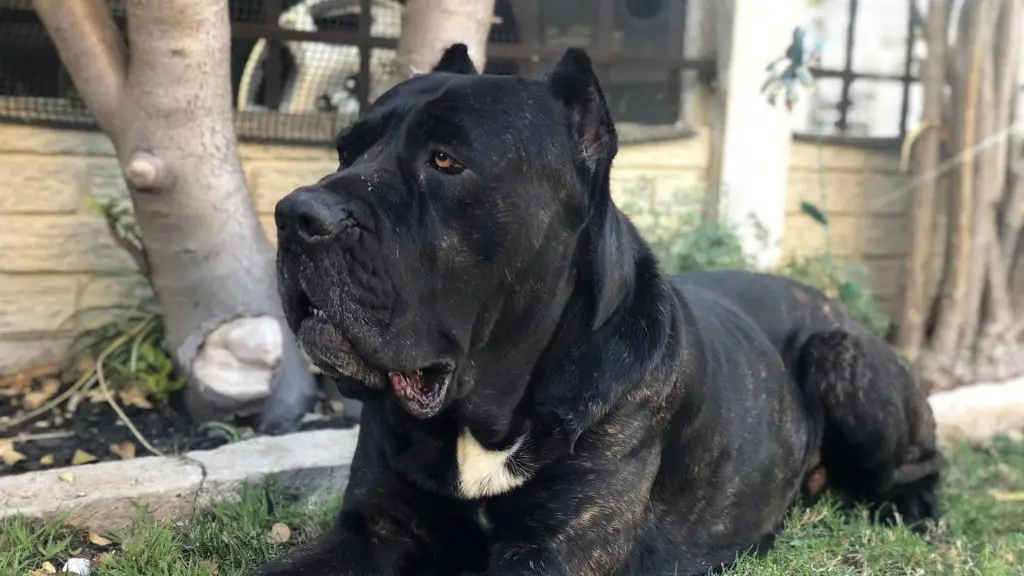
The practice of ear cropping can be seen back in ancient Greece. It is also mentioned in many Roman texts and artwork. In these early times, it was done for practical and cosmetic reasons.
In war, many dogs had their ears cropped to prevent enemies from grabbing them.
As time went on, the practice of ear cropping became more refined. In the 1800s, it became popular among European nobility to have their dogs’ ears cropped.
Cane Corsos were one of many dogs bred in the 1800s in Europe. However, they were specifically bred for hunting wild boar. During these hunts, their ears were often injured.
So to prevent this from happening, many people chose to have their Cane Corso’s Ears cropped.
Is Ear Cropping Illegal?
As of recent times, ear cropping has become less popular and is actually illegal in many countries. While there is still controversy over this practice, many believe it is inhumane and should not be done.
However, there are still places where this is a legal practice.
Here are the countries in which ear cropping is illegal:
- Australia
- Czech Republic
- Finland
- France
- Germany
- Greece
- Iceland
- Ireland
- Italy
- Netherlands
- Poland
- Russia
- South Africa
- Sweden
- Switzerland
- Turkey
- New Zealand
- United Kingdom
Here is a list of countries where it is still legal:
- Argentina
- Parts of Canada
- Chile
- Costa Rica
- Hungary
- India
- Japan
- Mexico
- United States
Even though some places still consider ear cropping legal, many veterinarians and animal welfare organizations are against the practice.
So even in legal states, some of these professionals refuse to do these surgeries (my family’s clinic is one of them).
What Age Do Cane Corsos Have Their Ears Cropped?
The most common age for Cane Corsos to have their ears cropped is 6 to 8 weeks.
At this age, it is easier for puppies to recover, and their ear cartilage has not fully developed.
At around 10 to 12 weeks, a Cane Corso’s ears are mostly done development. In addition, the cartilage in their ears is almost fully formed by 12 weeks.
This is why completing this procedure after 12 weeks can increase the risk of complications and increase the healing time.
Why Does Cane Corsos Have Their Ears Cropped? (6 Reasons)
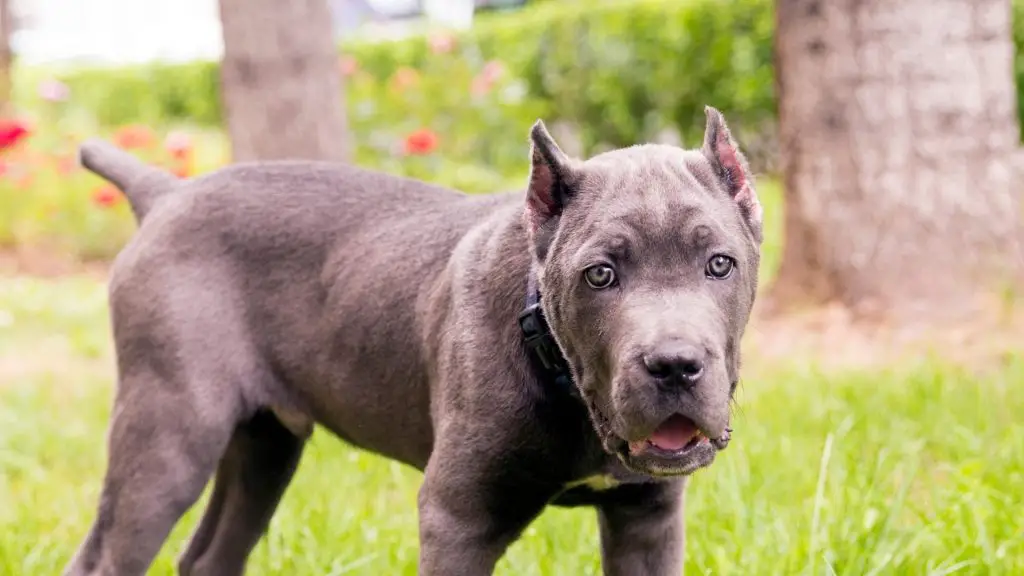
Now that we’ve shared the history of ear cropping, why do Cane Corsos have their ears cropped today?
Here are 6 reasons Cane Corsos still have their ears cropped:
#1 Breed Standard
The first reason is that owners want their Cane Corso to do well in dog shows. In the show ring, the American Kennel Club (AKC) recognizes Cane Corsos with natural and trimmed ears.
However, people believe there is still a slight bias toward Cane Corsos with cropped ears in the show ring.
This is because the best show dog’s faces are square and powerful. Cropped ears may improve the squareness of a Cane Corso’s face, increasing its chances of winning a competition.
Whereas uncropped ears may make its face appear rounder, which is unfavorable to the Breed Standard.
In addition, many breeders prefer to crop their dogs’ ears to conform to the ‘traditional’ appearance of the breed. Some argue that cropped ears give the Cane Corsos a more regal and powerful appearance.
#2 Protection & Safety
Another reason Cane Corsos have their ears cropped is for protection and safety. When working or playing, dogs can accidentally hurt their ears. This can cause the ear to be cut, scraped, or even ripped.
Cane Corso’s are less likely to sustain these types of injuries by having their ears cropped. This is especially important for working or hunting dogs.
Cropped ears give Cane Corso an advantage when hunting or working, as they reduce the ability to be injured or grabbed.
Therefore, their cropped ears give them an added advantage in these scenarios, as it is harder for their prey or other dogs to grab and hold on.
#3 Apperance & Cosmetics
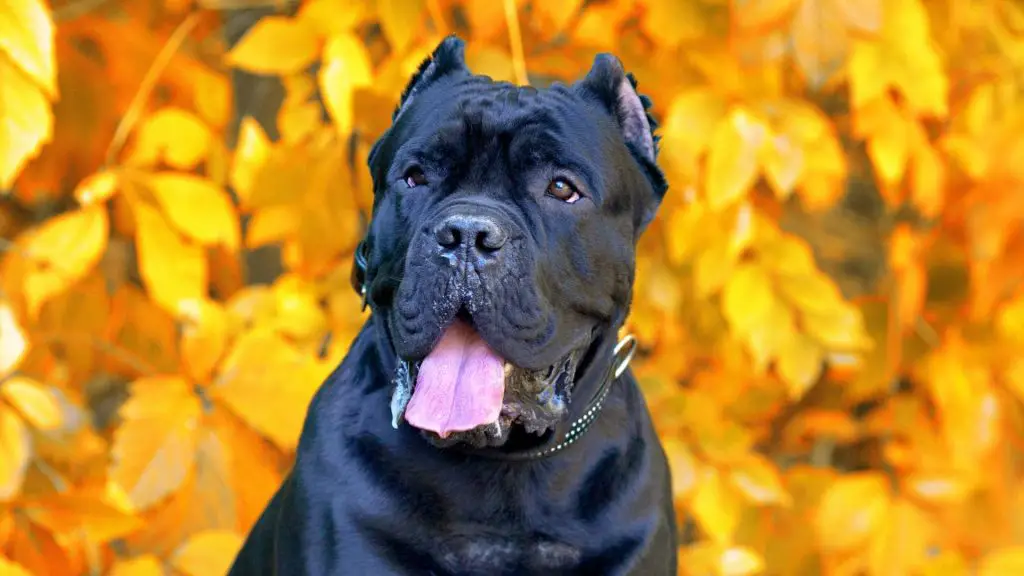
The third reason Cane Corsos have their ears cropped is for appearance and cosmetics. Some believe cropped ears look nicer or more aesthetically pleasing than natural ones.
While this may be a personal preference, it is still a contributing factor to why many Cane Corsos have their ears cropped today.
Some argue that cropped ears give the Cane Corsos a more ‘alert’ and ‘intelligent’ look.
In addition, many believe that the cropped ears give Cane Corsos a more ‘tough’ or ‘aggressive’ appearance. This may be why some people crop their dog’s ears if they want to use them as guard dogs.
#4 Reduces Infections
Another practical reason Cane Corso’s have their ears cropped is to reduce infections. Floppy ears create the perfect environment for bacteria growth.
The moisture and lack of aeration can also lead to yeast infections, which can be painful for dogs. In addition, when a dog’s ears are floppy, it can be challenging to clean them properly. Unfortunately, this can also lead to more infections.
So, Cane Corsos may be less likely to suffer from these infections by having their ears cropped.
However, with all this said, no scientific evidence suggests ear cropping prevents infection. Instead, this notion seems to be a logical assumption based on other information.
You see, dogs with long floppy ears are prone to ear infections. This is often seen in dogs with very long and floppy ears like the Basset Hound and Cocker Spaniel. Now, a Cane Corso does not have the same size ears or floppiness as these breeds.
So, is the assumption that cropping a Cane Corso’s ears could also reduce infections correct? It’s possible but not guaranteed or backed by any science.
#5 Improved Hearing
Cropped ears can, in fact, improve a dog’s hearing. This is because when a dog’s ear flops over, it can block sound from entering the ear. So when you remove the floppy parts of the ear, it no longer blocks sound.
It’s the same concept as covering your ears when you hear a loud noise. It helps to block out the noise.
The question really becomes, is the improvement to their hearing enough to warrant having their ears cropped?
That’s something you would have to decide for yourself.
#6 Decrease Infestations
Another possible reason Cane Corsos have their ears cropped is to decrease the risk of infestation. This is because when a dog’s ear flops over, it can create the perfect environment to hide for pests like fleas, ticks, and mites.
Dark, moist areas are the perfect breeding ground for these pests. So, by cropping a Cane Corso’s ears, you may be able to reduce the risk of infestation.
If these pests find their way into a dog’s ears and are not removed, they can cause serious problems.
Why You Might Not Want to Have Your Cane Corso’s Ears Cropped
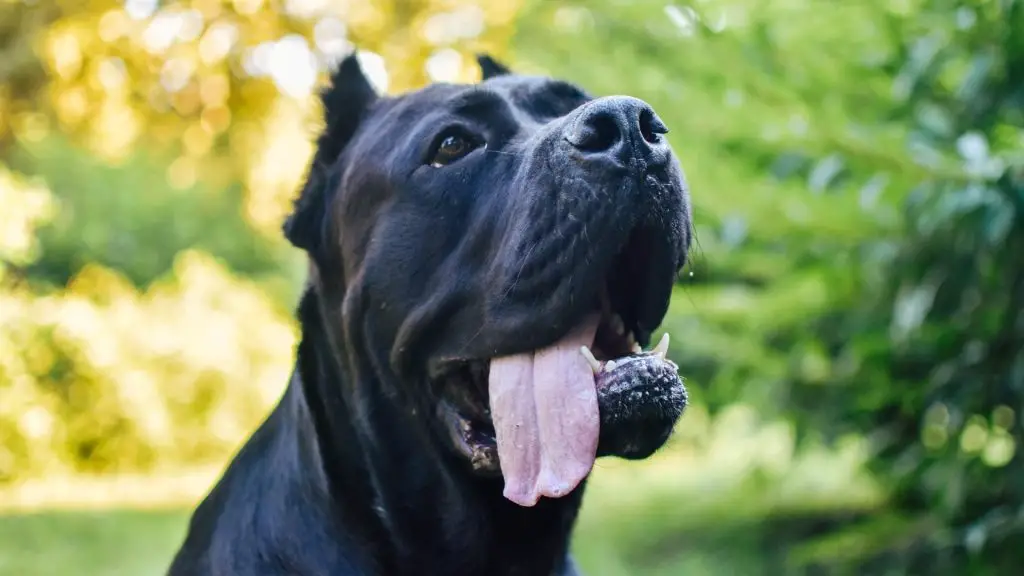
There may be several reasons for wanting to trim a Cane Corso’s ears, but there are also factors you should consider. Here are a few:
Surgical Risk & Pain
Every time your dog has surgery, they risk developing complications or infection.
Even after successful ear cropping surgeries, many dogs end up with sensitive ears that can cause pain. This is one of the risks associated with cutting part of a dog’s ears off.
In addition, a dog’s ear flap contains branches of the superficial carotid artery. This means there is a higher risk of uncontrolled bleeding when it is cut.
The ear tissue is densely packed with hundreds of tiny blood vessels that can bleed for an extended period during and after the procedure.
Reduces Natural Function
Cropping a Cane Corso’s ears can change how their ears naturally function, which is one of the main reasons ear cropping was banned in the United Kingdom in 2006.
When a Cane Corso’s ears are trimmed, their ears do not function the same way as they did before. They can’t pull or push, lower or flatten them the way they previously could before the procedure. So this could be hindering their ability to communicate.
Ear movements give a lot of information. Dogs use body language, including their ears, to communicate. So without their ears functioning as intended, you are giving them a handicap.
Floppy dog ears are also said to aid dogs with their sense of smell. When a dog’s ears are floppy, they may direct more air to their nose, improving their sense of smell. This is another function of a Cane Corso’s ears that is lost when cropped.
Cost
When surgically cropping a dog’s ears, general anesthesia is always required. This can be expensive, costing anywhere from $400 to over $1000. Some surgeons will charge even more than this base rate.
With these high fees in mind, you’ll need to decide whether or not cropping your dog’s ears is worth the cost before moving forward with the procedure.
Not Required
Generally speaking, there is no need to perform ear cropping. It used to be that breed standard required cropped ears. But this is no longer the case.
If you have a Cane Corso with uncropped ears, the AKC and the United Kennel Club (UKC) permit cropped and natural ears as the breed standard. So, you can successfully show your dog in AKC and UKC Conformation.
In fact, Cane Corsos with cropped ears is less common in the UKC show rings. This is due to the ear cropping ban in the United Kingdom.
So since it’s uncommon in the UKC and entirely prohibited in the Federation Cynologique Internationale (FCI), judges tend to favor a dog with natural ears since it conforms closely to the region’s usual appearance.
The FCI breed standard specifies that Cane Corso dogs should have natural ears of appropriate size. Therefore, a Cane Corso with cropped ears would be at a significant disadvantage in the show ring and unlikely to win any blue ribbons.
Is It Cruel To Crop Cane Corso Ears?
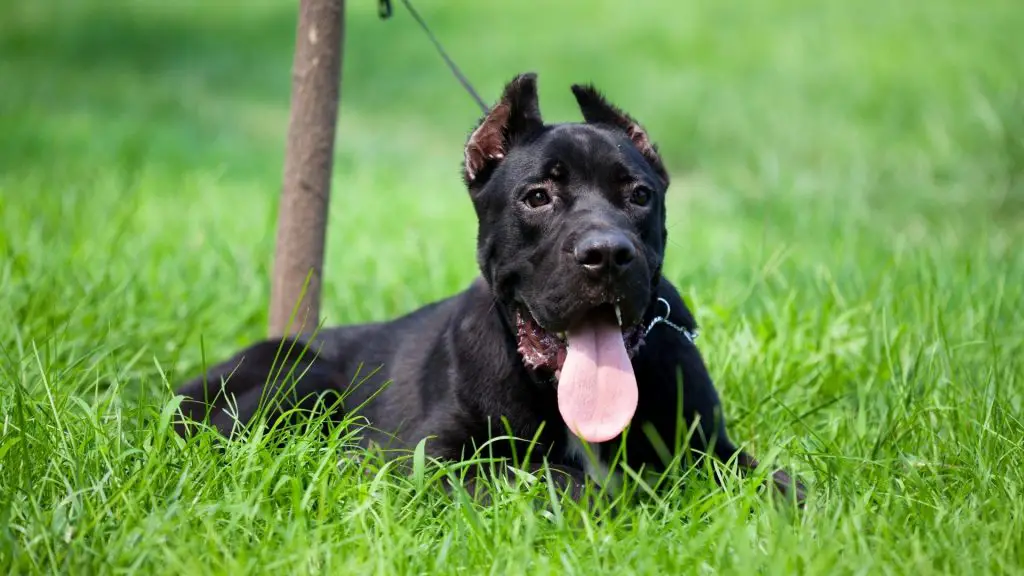
The answer to this question is controversial. Some people believe that ear cropping is cruel, while others do not think it necessary. Furthermore, there are pros and cons to cropping a Cane Corso’s ears. Therefore, educating yourself on the topic before making a decision is important.
Cropping a Cane Corso’s ears is often associated with animal cruelty when done for aesthetic purposes. However, if the procedure improves the quality of life or safeguards the dog, it isn’t considered inhumane to some.
The main argument against ear cropping is that it is unnecessary and painful for the dog. In addition, many people see it as mutilation. They believe it serves no purpose but to make the dog look “tough” or “threatening.”
While there are arguments for both sides, deciding whether to crop your Cane Corso’s ears is ultimately up to you. It also depends on where you live and if it’s legal or not.
When a Cane Corso gets their ears cropped, it can cause trauma and ear sensitivity and reduce some of the ears’ natural functions. But, on the flip side, ear cropping may help prevent ear infections, reduce the risk of injuries, and improve the dog’s hearing.
So when it comes to answering ethical questions about whether or not ear cropping is cruel, it really comes down to personal opinion and the reasons for doing so.
Cane Corso Ear Cropping Procedure: How Is Cropping Done?
The Cane Corso ear cropping procedure is done when the dog is around 8 weeks old. The vet will start by putting the dog under anesthesia. There are options to do this without anesthesia, but it is excruciating for the dog.
Once under, they’ll clean and disinfect the area before making an incision on the edge of the ear. How much they crop off will depend on the owner’s preference and what the surgeon is comfortable doing.
They then begin to remove any excess skin until they achieve the desired shape. Afterward, the vet will stitch up the ear.
The process usually takes thirty minutes to an hour, depending on the vet’s experience with ear croppings.
How Long Does Ear Cropping Take To Heal?
Cane Corso’s ears heal fairly quickly after cropping. On average, it will take about four to eight weeks for the ears to heal completely. Though some can take up to 3 months. Some people will tape their ears to help the cartilage heal in an upright position. During this time, it is important to keep the area clean and dry.
How Much Does Ear Cropping Cost For A Cane Corso?
The cost of ear cropping will depend on a few factors, such as the vet you use, your location, and whether or not your dog requires general anesthesia.
On average, expect to pay anywhere from $400 to $1000 for the procedure. Some breeders include ear cropping in the puppy’s price, while others will charge an additional fee.
Cane Corso Ear Care After Cropping
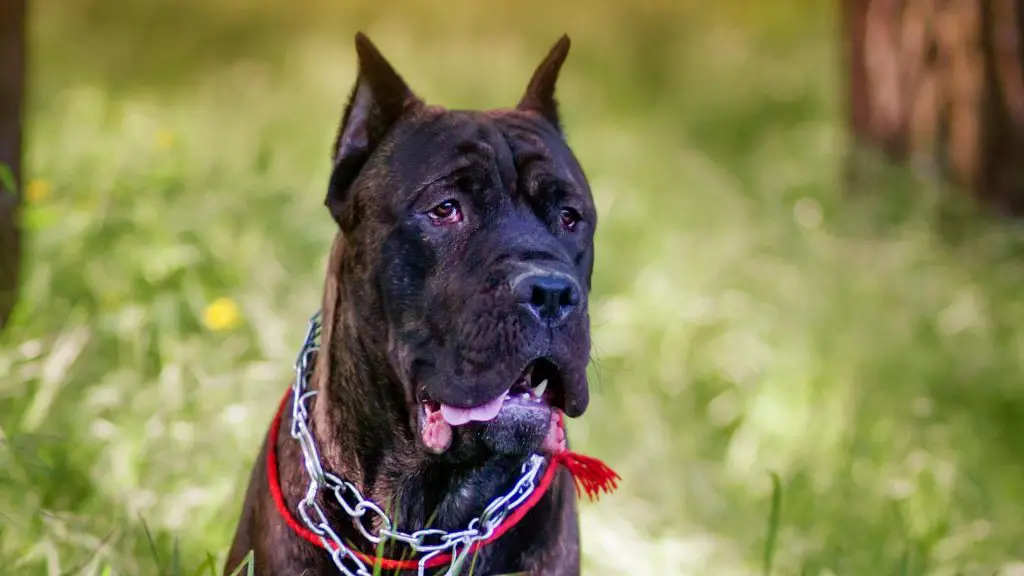
After the Cane Corso ear cropping procedure is complete, it is important to clean their ears regularly and watch for signs of infection. In addition, you always want to ensure the ears are not messed with while they are healing.
For cleaning their ears, an ear cleaning solution will be required to help them heal properly.
Once acquired, soak a cotton ball in the ear cleaning solution and gently wipe the inside of their ears. Be careful not to go too deep into the ear canal as this can cause damage.
After you finish cleaning your dog’s ears, put a thin layer of antibiotic cream or ointment on the incisions. Doing this will help stop any infections. Usually, the vet who cropped your dog’s ears prescribes it.
You should also keep a close eye on their ears for any signs of infection, such as redness, swelling, or discharge. Please take your dog to the vet if you see any of these symptoms.
Other Frequently Asked Questions
Can You Crop Older Cane Corso’s Ears?
It’s possible to crop an older Cane Corso’s ears, but it is not recommended. The ideal time to crop a Cane Corsos ears is between eight and twelve weeks old.
This is because they are still young, and their ear cartilage is softer, making the cropping process less painful. As they age, the cartilage in their ears will harden and become more difficult to crop.
Why Do Cane Corso’s Have Their Tails Cropped?
Tails are docked primarily to prevent injury. Cane Corsos often work as hunting and guard dogs, so to avoid their tails being stepped on or caught in things, they get cropped.
Docking the tail also makes Cane Corso look more intimidating, which is some people’s reasoning for cropping.
What Kind Of Ears Do Cane Corsos Have?
Cane Corsos has naturally floppy and triangular ears. Their ears are similar in shape to Labradors. However, when their ears are cropped, they stand up straight and pointy.
How Do Cane Corso Ears Stand Up?
A Cane Corso’s ears will stand up from a procedure known as ear cropping. After the Cane Corso ear cropping procedure is complete, the dog’s ears will be taped to a small piece of gauze.
The vet will wrap the tape around the base of the ear and then attach it to the gauze. The gauze will help to keep the ears in an upright position as they heal.
Final Thoughts
While it’s never been required to crop a Cane Corso’s ears, many people still choose to do so in certain parts of the world. In fact, some believe it’s crucial for their well-being and improves their overall health.
It may make sense for some people to crop their Cane Corso’s ears, while others may prefer to keep them natural. Ultimately, the decision should be up to the owner and what they believe to be the best for their dog.
The reasons for ear cropping today vary, but it can be for cosmetic or functional purposes. In some cases, people want the traditional look of the breed. Whatever the motivation, it is important to understand the procedure and what it entails before considering cropping a Cane Corso’s ears.
Other posts you might find interesting:
The Blue Cane Corso: Everything You Need To Know
